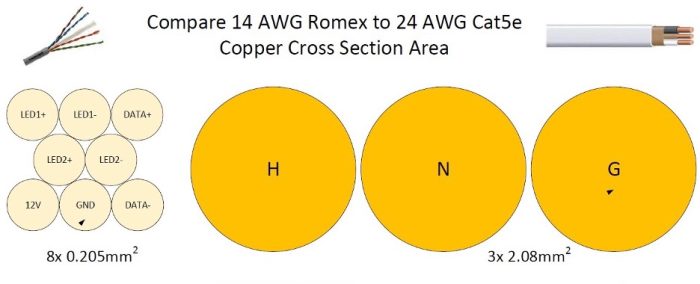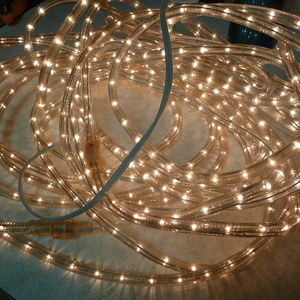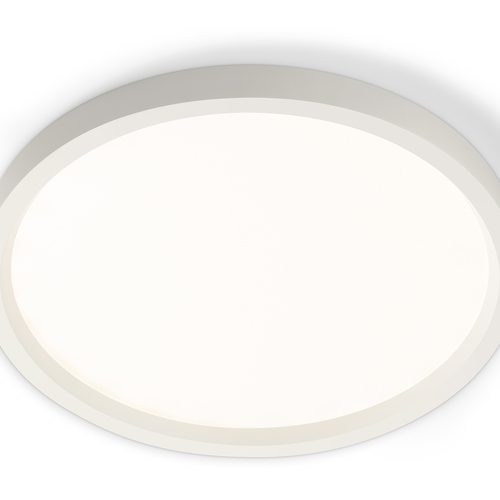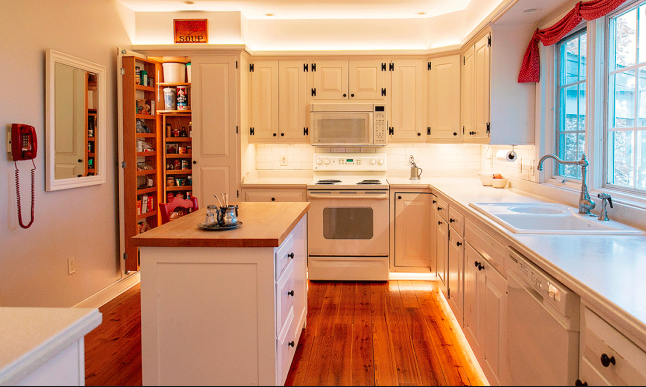
We may well be approaching “peak copper.” According to research firm BloombergNEF, by the early 2030s, copper demand could outstrip supply by more than 6 million tons per year. Because of increased demand, the price of copper is expected to soar by 75% by 2025 to as much as $15,000 per ton.
Meanwhile, according to copper.org, the average single-family home has 195 pounds of copper wire supplying 50 to 55 outlets and 15 to 20 switches. Each circuit can supply 1800 watts to outlets and light fixtures after being installed by licenced electricians (in short supply these days) and inspected for safety.
Copper overkill
But now we have light-emitting diodes (LEDs) and bulbs that draw about 10 watts. Every one of those bulbs has a transformer and a rectifier to convert the 120-volt alternating current (AC) to low-voltage direct current (DC), eating up some of those watts in the process. Even though they have electronic circuits to smooth it out, the LEDs sometimes have an annoying flicker.
Running LED lighting through heavy 14-ga. wiring makes no sense, and it’s not necessary. NEC Class 2 wiring systems, a relatively new type of power distribution, are limited to 100 watts and 60 volts per circuit but have more than enough juice to run LEDs; and companies are popping up to supply residential builders with systems that deliver smart lighting with less copper.

Derek Cowburn, CEO of LumenCache, has just introduced the ReNetA system, which runs on CAT-5 (RJ45) cables, the ones used for computer networks. It uses 60% less copper, with two LED circuits plus data taking up less cross-section than one 14-ga. wire, and that’s after accounting for twice as many runs. It generally runs from one circuit on the breaker panel, replacing 5 to 10 breakers normally serving different lighting circuits. The fixtures use less power and last longer because they run…
Weekly Newsletter
Get building science and energy efficiency advice, plus special offers, in your inbox.

This article is only available to GBA Prime Members
Sign up for a free trial and get instant access to this article as well as GBA’s complete library of premium articles and construction details.
Start Free TrialAlready a member? Log in















19 Comments
There is a paradigm shift coming for your "white goods" too. Industrial applications requiring high power are already shifting to digital power solutions such as https://voltserver.com/ (especially in high power telecommunication applications like cell tower transmitters, and power for the control systems in the Toronto subway).
I think DC makes sense for lighting. When I looked into this, I didn't think there were great solutions. The cost of install in the time domain far outweighed the cost of copper. Copper is ~$3/lb. If a house has 195 pounds, we are talking about $600. Maybe saving $100 worth to install this system, is it worth it? The added complexity of initial wiring seems to outweigh it's savings, but I do really like the idea of DC lighting powered from a single point rather than multiple transformers.
On the idea of converting homes to DC - I don't see this working on class 2. 100watts doesn't go far. My laptop charger is 150watts. 2 phones fast charging will max out a circuit. A TV, game console, coffee maker, etc, none of those things will run on 100watt. I looked into replacing a couple outlets with USB/combo ones, and even that I found pointless as they don't make enough power to fast charge a phone or power my laptop despite my laptop having a USB-C charge port.
What I think would make more sense would be implementation of 8amp 240v circuits or similar. Which would put us in line with the rest of the world anyway, so the goods already exist. Anything that converts to DC will be fine.
Agree. Using CAT5 or similar for lighting would be great especially if the cords use something convenient like RJ45 connectors. However, while DC power distribution makes sense for lighting, it doesn't make sense for most things in a home.
"almost everything we buy now runs on DC, our electronics, and even our cordless Dyson and Roomba vacuum cleaners. Outside of the kitchen or laundry, it is hard to think of an appliance that needs to run on AC (other than a hairdryer)."
Did they actually look at what's plugged in lots of homes? TV's, game consoles, computers, tablets, printers, fans, vacuums (even the cordless ones), (de)humidifers, and more all use more power than 100 Watts.
I was thinking of having to wire those tiny wires in. I've made a couple CAT6 cables and found it to be a finicky pain. But if you could just buy premade cables and plug in, no wiring required... that would be ideal, and even a time saver compared to romex.
CAT5/6 is a bit finicky. But I've found that a good crimper and after making a few it gets pretty easy. IMO easier than making standard romex wire connections (screw terminals or wire nuts) but not as easy as wego or similar quick connects.
I was mostly thinking of how easy it would be to replace a fixture that already has the CAT5 run - just unplug from the old fixture and plug into the new one. Same for replacing switches or other components.
USB can carry up to 450 watts, I agree that Class 2 won’t do the job. I should have been clearer about that!
Ok, that makes more sense. Although I'm not sure USB makes more sense than 120V AC distribution.
FYI, I was only able to find 240 W as the max for USB: https://en.wikipedia.org/wiki/USB_hardware#:~:text=The%20USB%20standard%20included%20power,requiring%20up%20to%20240%20watts.
Nice article. My brother in law , Dave Knapp, is a well known inventor who helped revolutionize LED lighting with his company Ketra, which invented advanced chips for LED lighting. Ketra was eventually acquired by Lutron. I recall 15 years ago talking with him about how low wattage lighting could be so important, especially in the Third World where the cost of copper was a huge stumbling block to providing modern lighting. He predicted back then that technology could cut copper usage dramatcially and told me even the largest homes would one day need only one lighting circuit, not just because the lights used so little wattage but also because they could be programmed to communicate without necessarily wiring back to switches or controllers.
Breaking into the electrical manufacturing realm is a tough game. There is so much consolidation and institutional norms that must be considered. The big electrical manufacturers have loyalty programs so distributors have an incentive to work with them only, not easy for the upstart to get a foothold.
This makes a ton of sense for home lighting. Especially since in the networking world, there are a ton of devices that run off of Power over Ethernet (POE) already like security cameras, network switches, phones, etc. If the home lighting network used the POE standard for supplying power to lights using CAT 5/6, it would be a great step forward to making lighting simpler and easier to replace like the article noted.
I just hope we don't end up with a bazillion different competing communication protocols that mean you get stuck in a certain ecosystem for your lights. They should be platform agnostic with basic on/off and dimming functions working no matter what switch or controller they are paired with.
“[Deleted]”
Lloyd,
For decades, I've lived in a house that is wired for both 12 volts DC and 120 volts AC. It's important to emphasize that Watts = volts x amps. For appliances of the same wattage, an appliance that uses high-voltage AC will use wiring of a smaller gauge (using less copper) than an appliance that uses low-voltage DC. High-voltage systems save copper -- not low-voltage systems.
True, in the case of digital electricity systems (Class 4 power systems) the voltage is stepped up to 450VDC in order to minimize line loses and allow the transmission of several kilowatts of power (far beyond the USB-C PD standard of 250W which only goes up to 48V I believe) using the smaller class 2 wiring mentioned in Llyod's article (and it helps that DC is more efficient to transmit than AC at an equivalent voltage). The higher voltages are considered safe because of how the power is delivered (Class 4 is supposed to make it impossible to be electrocuted) using packets of energy interspersed with functional checks at about 700x per second. I can't say if the costs of the technology will ever balance out for residential use (and I personally prefer to keep things simple in my own home despite my professional background) but Class 4 systems are a total game changer commercially, so I won't be surprised if we see the technology bleeding over as costs come down and industry becomes familiar with the new tech.
https://www.necanet.org/neca-bicsi/schedule/session-detail/what-is-class-4-fault-managed-power#:~:text=Class%204%20systems%20are%20referred,can%20go%20into%20a%20fault.
Still only 600 W, at least in the version in that presentation. So it can be used for lighting and some electronics, but it won't really replace conventional receptacle and appliance circuits in a residential application. And it's more power than you need for lighting.
I'm going to go out on a limb and predict this system will be double the cost of the current method of hooking up LED lights, even after the 75% increase in price of copper. What makes a lot more sense to me would be for the code to allow 18 gauge wire to serve LED lights on standard 120V circuits.
2026 NEC (US electrical code) is likely to allow AWG 16 wire for 10 A lighting circuits. The 2023 code allows 10 A lighting circuits, but still requires AWG 14. A 10 A circuit is still too big--more lighting power than you need in a whole house--but at least it's saving some copper.
Toured a LumenCache project years ago... until they come up with nice quality lighting (not the fixture, the actual LIGHT emitted), I don't see switching to this for my projects. The thin 'wafer' LEDs probably work for the general population but the lighting quality is pretty poor. The best way to describe it visual noise - they just shower light everywhere and aren't focused.
When that is fixed, I'm in!
Why don't I hear any discussion about voltage drop? That has been a major concern for every low voltage lighting system I have done, whether outside landscape lighting or indoor LED strip lights that run over 10' long. In the LED strip lights, there is a visible difference in lumens output between the 2 ends if you loop it around on itself. In landscape lighting, 10 gauge wiring has been needed in the past to deal with voltage drop. What actually matters is amperage. So going with LEDs helps a lot with the voltage drop issue, as does using 24 volt systems rather than 12V, but it can still be an issue when many fixtures are daisy chained onto one circuit. So when I think of low voltage, I think of more copper, not less.
Joe,
See my comment above (Comment #11). The solution to voltage drop is to use a higher voltage (for example, 120 volts AC). That will use less copper.
Log in or become a member to post a comment.
Sign up Log in